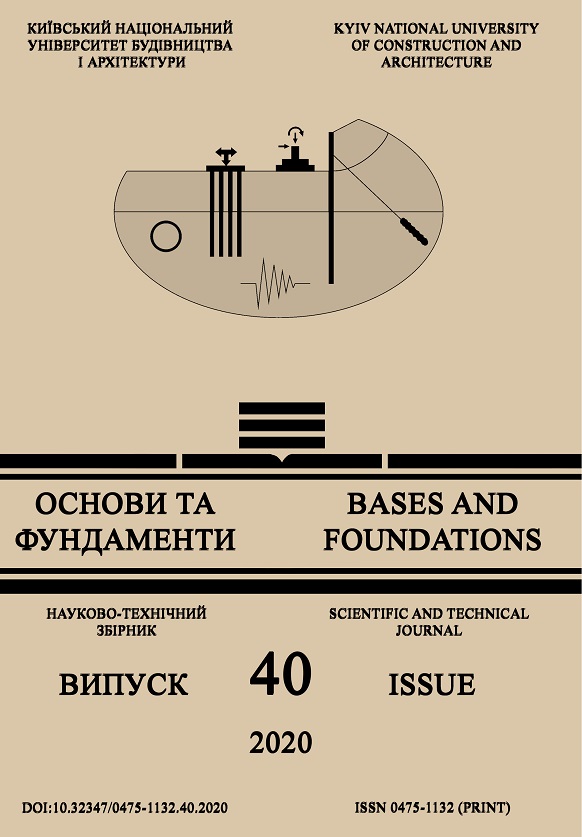Вплив параметрів підпірних стін та насипних ґрунтів на стійкість схилів при новому будівництві житлових комплексів
Основний зміст сторінки статті
Анотація
Досліджено стійкість схилу у існуючому і проектному положеннях, обґрунтовано конструктивні рішення підпірних стін по захисту території будівництва житлового комплексу в зоні схилу. Також додатково оцінено стійкість схилу при використанні раціональних протизсувних споруд.
Проаналізовано результати розрахунку стій-кості схилу для п’яти характерних перерізів на основі інженерно-геологічних вишукувань. Для кожного з наведених перерізів створено скінчено-елементну розрахункову схему у відповідності до останніх даних про зміну рельєфу. Так як схил утворений штучно шляхом засипання існуючого яру будівельним сміттям від знесення старих будинків та від розкопки котлованів під перші будинки комплексу. Розглянуто п’ять перерізів вздовж схилу та визначено його стійкість в природньому (існуючому) стані та проектному положеннях. Також обґрунтовано конструктивні рішення підпірних стін по захисту території будівництва житлового комплексу, так як вздовж схилу присутні різні насипні ґрунтові умови з різним перепадом висот. Це вимагає окремого підходу до вибору параметрів підпірних стін, а саме габаритів паль та їх взаємне розміщення, а також обґрунтовано вибір кута нахилу насипного ґрунту вздовж схилу.
Розрахунки проведені за допомогою числового моделювання напружено-деформованого стану системи «ґрунти схилу-підпірна стіна» з використанням методу скінченних елементів. Прийнята пружно-пластична модель деформування ґрунтів із зміною параметрів ґрунтів (модуля деформації) в залежності від рівня напружень у ґрунті. Використана модель Hardening soil model (HSM). Розрахунки стійкості схилу передбачають врахування технологічної послідовності зведення підпірних стін та моделювання поетапної розробки котловану. Моделювання виконувалось в декілька етапів: 1 етап – визначення напружень від власної вали, 2 етап – оцінка стійкості схилу до початку будівництва, 3 етап – влаштування паль підпірної стіни, 4 етап – оцінка стійкості схилу після проведення протизсувних заходів. На основі даних досліджень було розроблено практичні рекомендації по конструюванню кожної ділянки підпірної стіни відповідно до характерних перерізів.
Блок інформації про статтю

Ця робота ліцензується відповідно до Creative Commons Attribution 4.0 International License.
Автори, які публікуються у цьому журналі, погоджуються з наступними умовами: Автори залишають за собою право на авторство своєї роботи та передають журналу право першої публікації цієї роботи на умовах ліцензії Creative Commons Attribution License, котра дозволяє іншим особам вільно розповсюджувати опубліковану роботу з обов'язковим посиланням на авторів оригінальної роботи та першу публікацію роботи у цьому журналі. Автори мають право укладати самостійні додаткові угоди щодо неексклюзивного розповсюдження роботи у тому вигляді, в якому вона була опублікована цим журналом (наприклад, розміщувати роботу в електронному сховищі установи або публікувати у складі монографії), за умови збереження посилання на першу публікацію роботи у цьому журналі. Політика журналу дозволяє і заохочує розміщення авторами в мережі Інтернет (наприклад, у сховищах установ або на особистих веб-сайтах) рукопису роботи, як до подання цього рукопису до редакції, так і під час його редакційного опрацювання, оскільки це сприяє виникненню продуктивної наукової дискусії та позитивно позначається на оперативності та динаміці цитування опублікованої роботи (див. The Effect of Open Access).Посилання
Bоyko I.P. (2018). Napruzheno-deformovanyi stan zahlyblenykh sporud z vrakhuvanniam yikh zhorstkosti, tekhnolohii zvedennia ta kharakteru navantazhennia [Stress-strain state of deep structures taking into account their rigidity, erection technology and the nature of the load]. Osnovu i fundamenty: Mizhvidomchyj naukovo-tekhnichnyj zbirnyk. Kyiv: TOV «Vydavnytstvo» BARMY», 59, 60-72 (in Ukrainian).
Skochko L.O. (2017). Osoblyvosti chyslovoho modeliuvannia na-pruzheno-deformovanoho stanu bahatoiaru-snykh pidpirnykh stin z vrakhuvanniam zminy konfihuratsii yikh okremykh yarusiv [Features of numerical modeling of stress-strain state of mult-ilevel retaining walls taking into account configuration changes of their levels]. Naukovo-tekhnichnyi zbirnyk «Budivelni materialy, vyroby ta sanitarna tekhnika». Kyiv: «Vydavnytstvo Lira-K», 9, 227-231. (in Ukrainian).
Duncan J.M., Chang C.-Y. (1970). Nonlinear analysis of stress and strain in soils. ASCE Journal of the Soil Mechanics and Foundations Division. № 96 (SM5), 1629–1653.
Janbu N. (1973). Slope stability computation. Embankment-Dam Engineering. Casagtande volume. 47–86.
Kondner R.L. (1963). Hyperbolic stress strain response: Cohesive soils. Journal of the Soil Mechanics and Foundations Division. Vol. 89. Issue 1. 115–144.
Plaxis 2D 2015. (2015). Reference manual, Delft University of Technology & PLAXIS b.v. ISBN-13: 978-90-76016-18-4. The Netherland, 424.
Rowe P.W. (1962). The stress-dilatancy relation for static equilibrium of an assembly of particles in contact. Proceedings of the Royal Society of London. Series A, Mathematical and Physical Sciences. Vol. 269, No. 1339. 500–527. DOI: 10.1098/rspa.1962.0193
Schanz T., Vermeer P.A., Bonnier P.G. (1999). The Hardening Soil Model: Formulation and verification. Beyond 2000 in Computational Geotechnics. Balkema. Rotterdam. 81–290.
Inzhenernyi zakhyst terytorii, budivel i sporud vid zsuviv ta obvaliv. Osnovni polozhennia: DBN V. 1.1-46:2017. (2017). – Kyiv: Ministerstvo rehionalnoho rozvytku, budivnytstva ta zhytlovo-komunalnoho hospodarstva Ukrainy, 43. (in Ukrainian).
Nastanova z proektuvannya pidpirnykh stin: DSTU-N B V.2.1-31:2014. (2015). Kyiv: Minrehion Ukrayiny, 86. (in Ukrainian).
